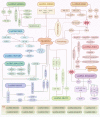Research Progress on the Inflammatory Effects of Long Non-coding RNA in Traumatic Brain Injury
- PMID: 35359568
- PMCID: PMC8961287
- DOI: 10.3389/fnmol.2022.835012
Research Progress on the Inflammatory Effects of Long Non-coding RNA in Traumatic Brain Injury
Abstract
Globally, traumatic brain injury (TBI) is an acute clinical event and an important cause of death and long-term disability. However, the underlying mechanism of the pathophysiological has not been fully elucidated and the lack of effective treatment a huge burden to individuals, families, and society. Several studies have shown that long non-coding RNAs (lncRNAs) might play a crucial role in TBI; they are abundant in the central nervous system (CNS) and participate in a variety of pathophysiological processes, including oxidative stress, inflammation, apoptosis, blood-brain barrier protection, angiogenesis, and neurogenesis. Some lncRNAs modulate multiple therapeutic targets after TBI, including inflammation, thus, these lncRNAs have tremendous therapeutic potential for TBI, as they are promising biomarkers for TBI diagnosis, treatment, and prognosis prediction. This review discusses the differential expression of different lncRNAs in brain tissue during TBI, which is likely related to the physiological and pathological processes involved in TBI. These findings may provide new targets for further scientific research on the molecular mechanisms of TBI and potential therapeutic interventions.
Keywords: immune response; inflammatory pathways; long non-coding RNA; therapy; traumatic brain injury.
Copyright © 2022 Wang, Li, Ding, Peng, Xiao, Chen and Cheng.
Conflict of interest statement
The authors declare that the research was conducted in the absence of any commercial or financial relationships that could be construed as a potential conflict of interest.
Figures



Similar articles
-
The role of long noncoding RNA in traumatic brain injury.Neuropsychiatr Dis Treat. 2019 Jun 28;15:1671-1677. doi: 10.2147/NDT.S206624. eCollection 2019. Neuropsychiatr Dis Treat. 2019. PMID: 31303755 Free PMC article. Review.
-
Coding and long non-coding gene expression changes in the CNS traumatic injuries.Cell Mol Life Sci. 2022 Feb 7;79(2):123. doi: 10.1007/s00018-021-04092-2. Cell Mol Life Sci. 2022. PMID: 35129669 Free PMC article. Review.
-
Long Non-coding RNA in CNS Injuries: A New Target for Therapeutic Intervention.Mol Ther Nucleic Acids. 2019 Sep 6;17:754-766. doi: 10.1016/j.omtn.2019.07.013. Epub 2019 Jul 29. Mol Ther Nucleic Acids. 2019. PMID: 31437654 Free PMC article. Review.
-
Alteration in Long Non-Coding RNA Expression after Traumatic Brain Injury in Rats.J Neurotrauma. 2017 Jul 1;34(13):2100-2108. doi: 10.1089/neu.2016.4642. Epub 2017 Mar 21. J Neurotrauma. 2017. PMID: 28145813
-
The Involvement of Long Non-coding RNA and Messenger RNA Based Molecular Networks and Pathways in the Subacute Phase of Traumatic Brain Injury in Adult Mice.Front Neuroinform. 2022 Mar 4;16:794342. doi: 10.3389/fninf.2022.794342. eCollection 2022. Front Neuroinform. 2022. PMID: 35311004 Free PMC article.
Cited by
-
The Role of Microglial Exosomes and miR-124-3p in Neuroinflammation and Neuronal Repair after Traumatic Brain Injury.Life (Basel). 2023 Sep 16;13(9):1924. doi: 10.3390/life13091924. Life (Basel). 2023. PMID: 37763327 Free PMC article. Review.
-
IFI204 in microglia mediates traumatic brain injury-induced mitochondrial dysfunction and pyroptosis via SENP7 interaction.Cell Biol Toxicol. 2025 May 23;41(1):89. doi: 10.1007/s10565-025-10032-8. Cell Biol Toxicol. 2025. PMID: 40407969 Free PMC article.
-
Potential Correlation Between Molecular Biomarkers and Oxidative Stress in Traumatic Brain Injury.Int J Mol Sci. 2025 Apr 18;26(8):3858. doi: 10.3390/ijms26083858. Int J Mol Sci. 2025. PMID: 40332547 Free PMC article. Review.
-
Inflammatory response in traumatic brain and spinal cord injury: The role of XCL1-XCR1 axis and T cells.CNS Neurosci Ther. 2024 Jun;30(6):e14781. doi: 10.1111/cns.14781. CNS Neurosci Ther. 2024. PMID: 38887195 Free PMC article. Review.
-
LncRNA CRNDE binds hnRNPA1 to facilitate carbon monoxide poisoning-induced delayed encephalopathy via inhibiting UCHL5-mediated SMO deubiquitination.Metab Brain Dis. 2023 Mar;38(3):1097-1113. doi: 10.1007/s11011-022-01157-4. Epub 2023 Jan 17. Metab Brain Dis. 2023. PMID: 36648699
References
-
- Albert V., Arulselvi S., Agrawal D., Pati H. P., Pandey R. M. (2019). Early posttraumatic changes in coagulation and fibrinolysis systems in isolated severe traumatic brain injury patients and its influence on immediate outcome. Hematol. Oncol. Stem Cell Therapy 12 32–43. 10.1016/j.hemonc.2018.09.005 - DOI - PubMed
Publication types
LinkOut - more resources
Full Text Sources

